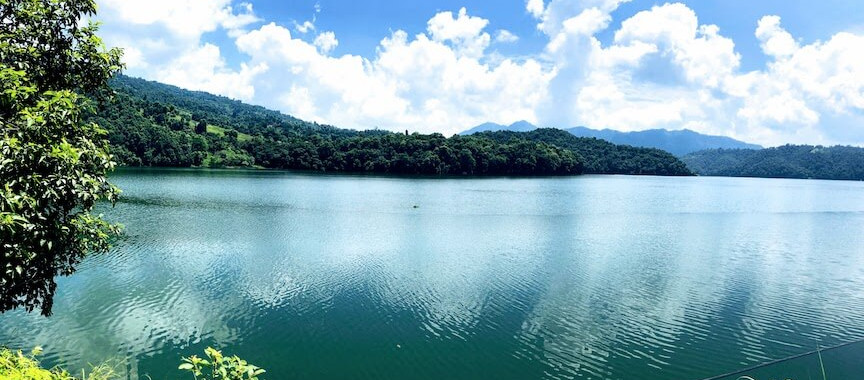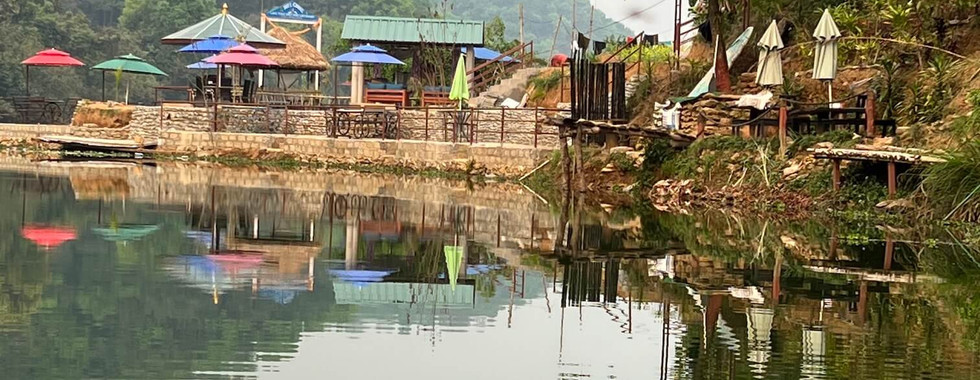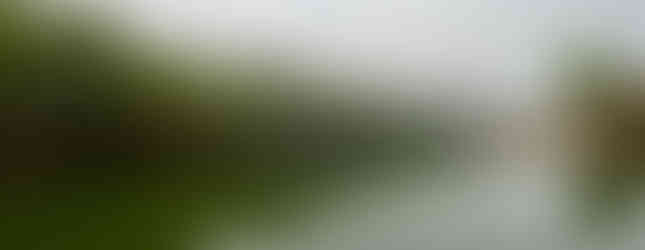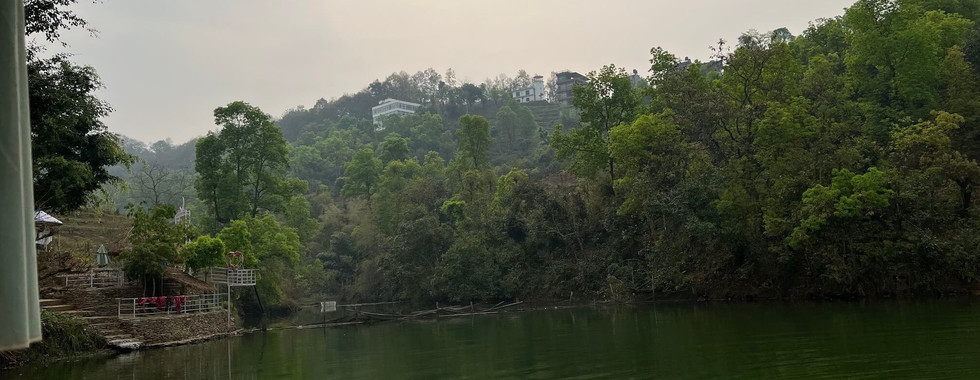Find Adventure and Relaxation in Pokhara, the Lake District of Nepal
- Travel Maker South Asia

- Jan 5, 2023
- 5 min read
POKHARA
Pokhara is one of Nepal's must-visit destinations and is situated 200 km west of Kathmandu. One can either take the seven-hour drive or the approximately 20-minute flight there; or even partially make the journey by seeking more adventure in the form of rafting almost halfway there ( you will drive the rest of the way )
Also known as the 'Lake District of Nepal,' the tranquil lakes and spectacular mountain views are not the only reason Pokhara is visited. It is the idyllic staging point for the famed Annapurna Circuit and Annapurna Sanctuary Treks. It also serves as a watering hole or a recuperating paradise after a rigorous trek in the Annapurna region.
The towering and easily recognizable Mt. Fishtail ( Machhapuchhare ) and its sister peaks, the tranquil lakes that mirror these snow-clad mountains, and lakeside bars and restaurants provide the ultimate surroundings for tourists and travelers of all genres.
Over the recent decades, besides boating and fishing on the lakes, Pokhara has also introduced other adrenaline activities like parasailing, micro-light flights, zip line, foothill hikes, and many more. Its excitingly unique physical and cultural features ( some of which are outlined below ) also allow you to do some exploring.
Phewa Lake
Approximately 1.5 by 4 kilometers, Phewa Lake, is the second largest lake in Nepal and is the focal attraction in Pokhara. The Idyllic lake surroundings give you an excellent reason to lazily relax on a boat that can be rented at moderate prices. As you do so, you can gaze at the stunning panorama of the Annapurna ranges. The lake's eastern shoreline, also known as Badam or Lakeside, is dotted with shops, restaurants, bars, and souvenir shops. This area commands magnificent views.
Begnas Lake & Rupa Lake
These lakes are located 15 km from Pokhara from the end of a road that turns north from the highway heading to Kathmandu. It is divided by a forested hillock or 'Pannchabhaiya Danda.' The seclusion of this isolated area is an ideal nature retreat and can do wonders for your senses. One can even opt for boating and fishing.
Barahi Temple
The Barahi Temple is Pokhara's most significant religious site and is almost in the middle of Phewa Lake. The temple is a two-storeyed Pagoda dedicated to the boar manifestation of Ajima (protectress deity ), representing the female force Shakti. On Saturdays, one can observe devotees carrying male animals and fowl across the lake to make sacrifices and offer them to the deities.

World Peace Pagoda
This massive Buddhist structure is situated on the top of a hill on the southern shore of Phewa Lake. Apart from being a spectacular site, it also offers a breathtaking view of Pokhara and the panoramic Annapurna range. It is accessible once you cross the lake and hike uphill.
Seti Gandaki
This gushing river flows through the city and, in many places, flows underground. Astonishingly, the river is a mere 2 meters wide at some locations. The depth of the river is up to 20 meters. Mahendra Pull ( Bridge ) is an excellent spot to view these phenomena; the valleys are profound and narrow to understand the river's power and the gorges' depth. Mahendra Pull is near the Mission Hospital.
Devi's Fall
Locally referred to as Patale Chango ( Hell's Fall ) and also known as Devin's or David's Fall, this incredible waterfall is located 2 km southwest of Pokhara Airport on the highway to Tansen. According to modern-day legend, a man named David was skinny dipping in the river when the dam's floodgates were opened; he was swept into the underground passage beneath the fall and never found.

Gupteswar Gupha ( Gupha – Cave )
This sacred cave is located 2 km from Pokhara Airport on the Siddhartha Highway, leading southwest of Pokhara. The entrance is right across from Devi's Fall. The cave is 3 km long and has large open spaces and, at certain places, passages that are so low and narrow that you would have to go down on all fours to navigate your way through. A well-preserved phallic symbol of Lord Shiva can be seen here. It is still in the same condition as when it was first discovered. One has to pay a nominal fee for entrance. Photography is prohibited here.
Mahendra Gupha
Known locally as Chamero Gupha ( Bat Cave ), it is a unique limestone cave and is presumed to have been discovered by local shepherd boys. The cave is accessible to the north of Pokhara after a two-hour walk. It is advisable to carry your torchlight to look at the stalactites and stalagmites in the cave.
The Old Bazaar
This vibrant, colorful, and exciting bazaar is a melting pot of ethnically diverse traders who sell and purchase anything from livestock and tools to farm products. One can notice the Newari cultural influence in the various temples and monuments. The bazaar is 4 km from the lakeside and retains its old and rustic charm.
Bindyabasini Temple
This temple is the center of religious and spiritual activity in the Old Bazaar. The temple is built in dedication to Goddess Bhagwat, who is considered to be another manifestation of shakti. The place has a festive and fair-like atmosphere when animal sacrifices are made.
Museums
The museum is located between the airport and Mahendra Pull. It showcases the ethnic diversity of Western Nepal along with the lifestyle, culture, and history of the Gurung, Thakali and Tharu people, who form the bulk of the population in this region. The museum is open from 10 am to 4 pm except for Tuesday. There is a nominal entry fee and an extra fee for cameras.
Annapurna Museum
Also known as the Natural History Museum, it is located at the Prithvi campus east of the Old Bazaar. The Annapurna Conservation Area Project ( ACAP ) manages the museum and houses exciting collections of butterflies, insects, birds, and wildlife models. Besides such treasures, it also displays precious and semi-precious stones and volcanic rocks. It is open every day, except Saturdays and public holidays, from 9 am to 4 pm. Entry is free.

Himalayan Vista
One can get magnificent views of the Annapurna ranges on the northern skyline of Pokhara. The prominent peaks on the Annapurna Massif are Annapurna I – Annapurna IV and the distinctive Machhapucchare ( twin peaks ). Besides these peaks, other prominent ones are Himchuli, Varahashikar, Gangapurna, and various other peaks. These peaks can either be hidden or partially visible during April- September. It is a rejuvenating experience to sit on the shores of Phewa Lake with the mountains as a backdrop, especially in the evenings.

Nightlife and Entertainment
Over the decades, the city of Pokhara has transformed itself from a sleepy little town to a bustling and vibrant tourist hub, mainly because of trekkers who use the city as their starting and ending point for their Annapurna treks. Though the town shuts down from 10: 30 pm onwards, one can still find his way to pubs and bars that either put on cultural shows or live bands that belt out covers of famous artists. The food in the restaurants also serves various cuisines ranging from pizzas and burgers to Chinese and continental.
In Conclusion
In conclusion, Pokhara is a must-visit destination in Nepal that offers a variety of attractions and activities for travelers, including stunning mountain views, tranquil lakes, and a range of adrenaline-pumping activities. It is also an ideal staging point for Annapurna Circuit and Annapurna Sanctuary Treks and serves as a recuperating paradise after a rigorous trek in the region. Some notable sights and landmarks in Pokhara include Phewa Lake, Begnas Lake, and Rupa Lake, Barahi Temple, World Peace Pagoda, Seti Gandaki, Devi's Fall, Gupteswar Gupha, and the International Mountain Museum.
To know more and book your trip to Pokhara, kindly feel free to talk to us


































































Comments